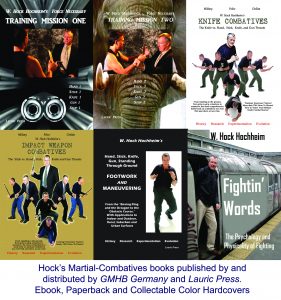
Everyone is different and I work off of the “who, what, where, when, how and why” questions to win and-or survive, and-or problem-solve. The big 4 groups…
- police,
- military,
- martial arts and the
- “aware citizenry”


Everyone is different and I work off of the “who, what, where, when, how and why” questions to win and-or survive, and-or problem-solve. The big 4 groups…

In 1986, I became fascinated by the Bruce Lee’s essay on “the stance of no stance,” idea. Whether hand, stick, knife or gun, I opted for the loose “ready stance,” and the “balance and power in motion” concept, a motion-picture-idea rather than a still-photo-idea.
Thanks to Bruce Lee, the Inosanto Family (and Ed Parker) when teaching since the late 1980s, I organized and demonstrated the Ten Probable Position-Problems to prepare people for the full spectrum of mixed weapon fighting possibilities. I was a cop then and we had to fight on the ground periodically, so even before the BJJ madness-fad, many of us trained in a diverse Police Judo, later re-named Police Defensive Tactics (both very incomplete). And, I was deeply involved with the Inosanto Family and they were deeply involved in “shooto” – “shoot wrestling.”
One might say there are three generics in “street fighting-survival” challenges. 1) standing, 2) kneeling-seated, 3) floor-ground. But inside each there are differing heights and needs, making up the ten. For me a system-art that spends too much time in one of the categories is forgetting the importance of the others. In any fight you may well transition through some of these ten. Investigate them through the Ws and H Questions, the who, what, where, when, how and why questions to best explore combatives. One such “Where” question is…”Where are you?” Standing? Kneeling? Seated? Floored-grounded?
YOU WILL BE FIGHTING “HERE”… In many a fight, certainly an ambush, you might never get a chance to strike up a defined “stance.” Still, this study reminds everyone that fighting includes all these up-and-down height categories and they should not be ignored or forgotten.
EVERYTHING you learn, must be experimented through these 10 position (stance) problems. Every strike, kick, lock, etc…can you do it there? Can it work here? There? Up and down? Yes or no? This is the goal of the seamless survival fighter. You fight where you fight, where you are. A true fighter-survivor, so-called “combatives” person, fights standing, kneeling-seated and on the floor-ground, in and out of buildings, in rural, suburban and urban areas. Dissect, identify and discard sports and artsy cancers. A combatives fighting system is about doctrine-doctrine-doctrine, the training skeleton which recognizes chaos, crime and war and best prepares people to respond.
I ask again, “Where are you?”
________________________
Hock’s email is HockHochheim@ForceNecessary,com
Get these Training Mission, second-edition books in Ebook, oversized paperback and full color, collectable hardcover textbooks. Hundreds of pages of thousands of how-to photos. (there will eventually be about six Training Mission books. Click here
The who, what, where, when, how, and why do you want to tackle a criminal, your “drunk uncle (relative) or an enemy soldier? If you tackle someone in the real un-matted, world, you will usually end up on the carpet, tile, floor, cement, asphalt, dirt, rocks, grass etc. of the indoor and outdoor, rural, suburban and urban theaters of life. Often times some may well be wearing enforcement uniforms and gear, or in regular clothes. Run through the “Ws and H” questions for your lifestyle, location and needs and predict where you might be tackling someone. This essay is NOT about the pros and cons of ground even though it must be mentioned once in a while. This essay is just about “tackling the tackle” or ” “tackle or not to tackle.” in terms of how to and how to survive.
Being tackled is one of the four main ways we hit the ground in the fight, so says a number of universities with police science, criminology departments years back, gathering a smattering of stats as best they could for Caliber Press. Those big four ways, briefly, and in order (!) are these:
Even with only a smattering of research, the 4 mentioned seem very logical. In the Stop 5 of my Stop 6 program, it is nicknamed “Bear Hugs” is all about “bear hugs” and this arm-wrap, tackle subject. The single arm, and double arm “bear hugging” includes “hugging” the legs and is called “Tackle and Countering the Tackle.” We must learn the ways and moves of the opponent too, to counter those moves. Here are the main and common tackles we exercise through in the hand, stick, knife, gun courses as a foundation for you to springboard into deeper studies:
Common Sport-Based Tackles (which can, of course, work in “real life,” too) examples:
Non-Sport Tackles Examples:
Common Counters to Tackles
Experiment with these foundational moves, then is you wish, continue on deeper.
Email Hock at: HockHochheim@ForceNecessary.com
_________________
Get Training Mission One and Training Mission Two, second editions. Hundreds of pages with several thousand, how-to photos. Look for them, click here